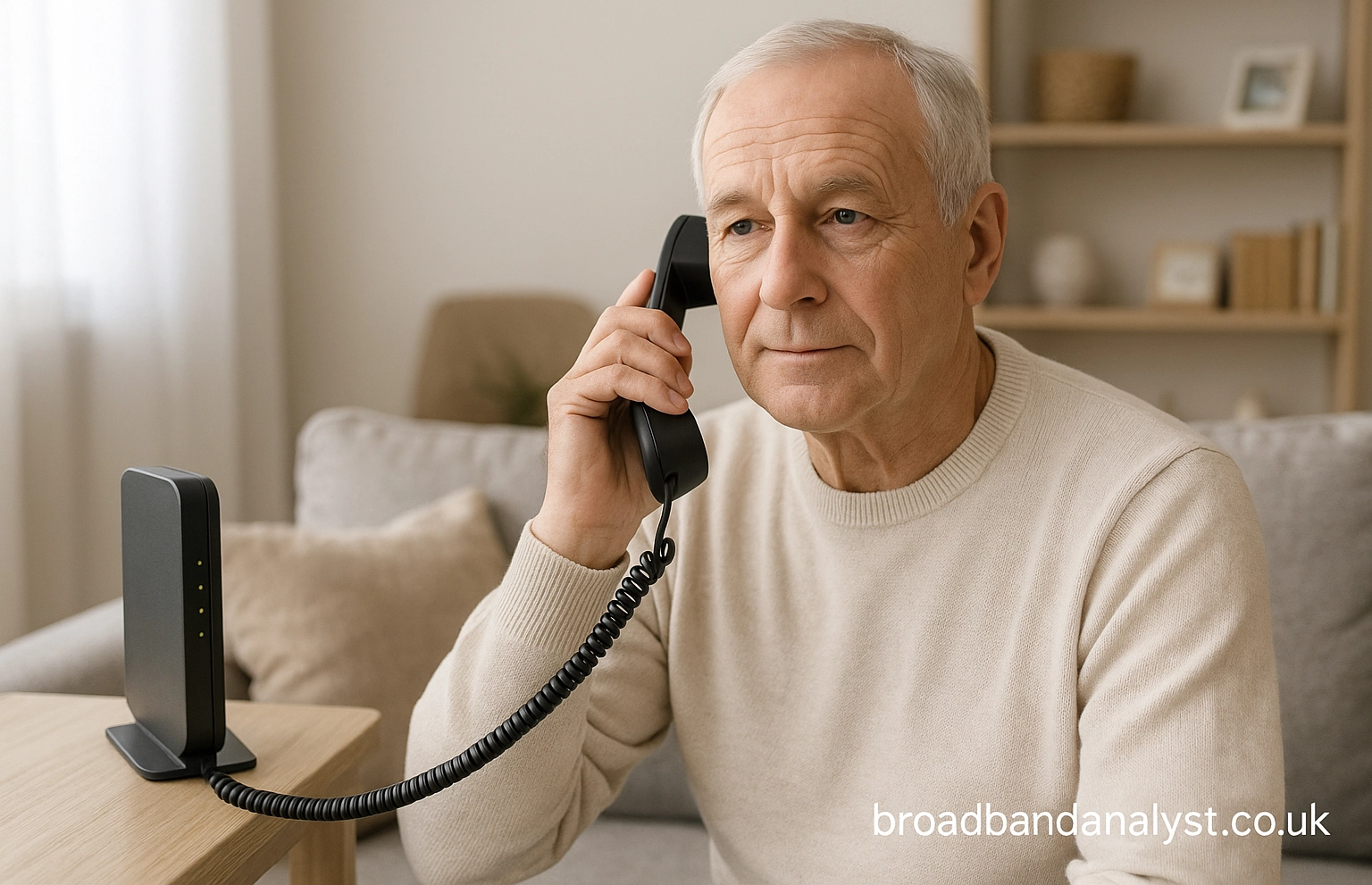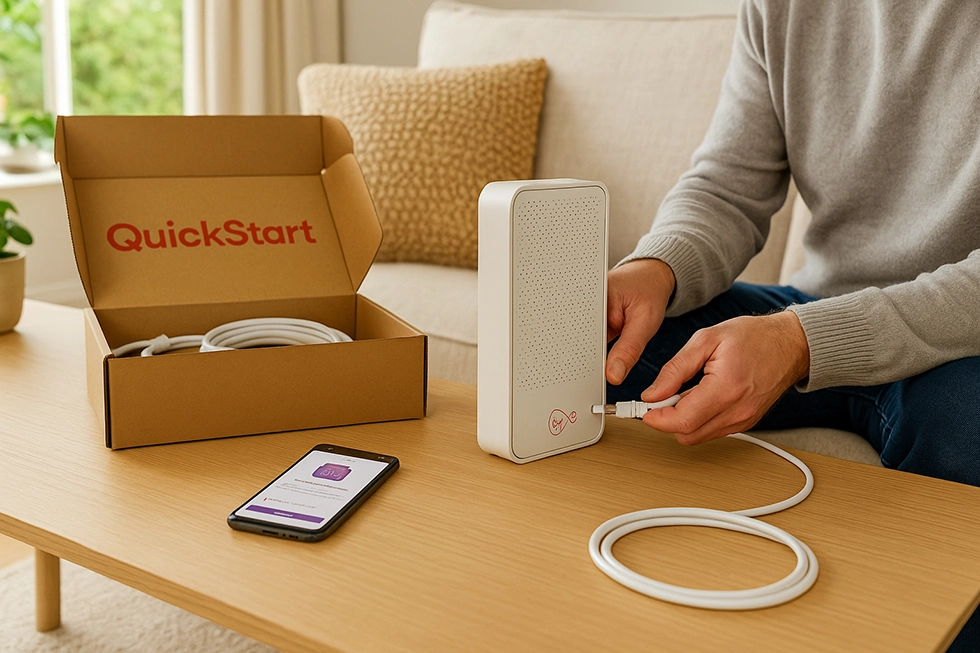Moving from FTTC to FTTP – Will I lose my phone service?
Switching from fibre to the cabinet (FTTC) to fibre to the premises (FTTP) is becoming routine across the UK as Openreach and alternative networks extend full fibre coverage. One question comes up time and again before people make the jump: what happens to the home phone line.
FTTP connections provide internet only and don’t include a standard phone line. If you want to keep using a landline, you’ll need a digital phone service that runs over your broadband connection. Below, we explain how that works, what to expect on the day, and the simple steps that help you avoid losing your number.

FTTC and FTTP explained
FTTC brings fibre to your local green street cabinet, then hands off to the older copper pair from the cabinet to your home. That copper leg can carry a traditional landline using the old telephone system, unless you’re already on a broadband-only variant such as SOGEA.
FTTP replaces the copper leg entirely. A fibre runs all the way into your property and connects to an optical network terminal, or ONT, which is usually mounted on an inside wall near a power socket. Because FTTP is designed for data, it does not carry an analogue dial-tone to the wall sockets. If you want a home phone, it needs to run as a digital voice service through your broadband router or a small telephone adapter.
The practical change is simple. On FTTP, plugging a handset into an old wall socket will no longer work for calls. Instead, the phone plugs into the phone port on your router or into a supplied adapter.
Why moving to FTTP affects your phone line
The UK is retiring its ageing analogue telephone network. The Public Switched Telephone Network and the Wholesale Line Rental products built on top of it are scheduled to be withdrawn on 31 January 2027. Providers are moving customers to all-IP calling, where your phone service rides over the broadband link rather than over a separate copper voice circuit. Whether you upgrade to FTTP now or later, your home phone ultimately becomes a digital service.
Will you lose phone service during the switch
What happens depends on what you order and when you port your number.
FTTP with a digital phone add-on
If you take FTTP with your provider’s digital voice option, your landline number is normally moved across to the new service. You may notice a short break while the service switches, but once your router is active and the phone is plugged into the router’s phone port or adapter, calls resume as normal.
FTTP on a broadband-only package
If you order FTTP without a phone service, your old copper-based landline will be stopped as part of the migration. Unless you have arranged to move your number elsewhere beforehand, that number is typically lost.
Porting your number to an independent VoIP provider
You can keep the same number by porting it to a third-party VoIP service, but it’s important to initiate the port before the old line is ceased. Leave the cancellation to the gaining provider so the number stays live until the port completes.
What to expect on installation day
An engineer will install the ONT and connect it to your new broadband hub. If you have taken a digital voice service, you simply move the telephone lead from the wall socket to the phone port on the router or to any adapter provided with the kit. There may be a brief period where the phone stops working while the number activates on the new platform. Once the switch completes, calls in and out resume. After migration, the old wall sockets no longer carry a working dial-tone.
Keeping your existing phone number
Number portability in the UK lets you keep your landline number when you change providers or technologies, but the sequencing matters.
Do not cancel the old line yourself. If the line is ceased before a port request is in progress, the number is usually lost. Start the port with your new provider or with your chosen VoIP company and allow a few working days for completion. During that time, your old service remains active, and the cease happens automatically after the port is done.
You can move the number onto your broadband provider’s own digital voice product, or you can port it to an independent VoIP service if your broadband plan does not include calls.
Power cuts and calling 999
Digital phone services rely on mains power for the router and ONT. If the power goes off, the landline will not work unless you have a backup solution. Providers are expected to support vulnerable customers who rely on a landline for emergency calls, with a minimum standard of one hour of backup power. Options vary by provider. BT and EE supply battery backup units for the hub in some cases. Virgin Media can provide an Emergency Backup Line that keeps a basic phone service available during outages. Other providers offer similar solutions on request.
If you live somewhere with poor mobile reception or you use telecare equipment that depends on a fixed line, raise power-backup options with your provider before you switch.
What major UK providers offer on FTTP
BT and EE offer Digital Voice that plugs into the Smart Hub. You can usually keep your number, and battery backup options are available for customers who need resilience.
Sky provides Internet Calls that connect via the Sky hub. As with other digital services, it will not work in a power cut without backup power.
Vodafone supplies a Digital Voice option on FTTP. Number ports for residential customers typically complete within a couple of working days once submitted.
TalkTalk offers Digital Voice and can provide a separate adapter if your router lacks a built-in phone socket.
Plusnet delivers FTTP as broadband-only. There is no landline add-on, so customers who want a home phone typically port the number to an independent VoIP provider.
Virgin Media moves the phone to the hub when you migrate to their fibre platform. Most customers keep the same number, and an Emergency Backup Line is available for those who rely on voice service.
Zen and KCOM both support digital voice on their fibre lines, and many alternative networks, including Community Fibre, YouFibre and Hyperoptic, sell optional VoIP add-ons or point customers to third-party VoIP services.
| FTTP Provider | Landline add-on |
|---|---|
| BT | Digital Voice via Smart Hub; usually keep number; backup options available. |
| EE | Digital Voice via Smart Hub; usually keep number; backup options available. |
| Sky | Internet Calls via Sky Hub; won’t work in power cuts without backup. |
| Vodafone | Digital Voice on FTTP; number ports typically complete in a couple of working days. |
| TalkTalk | Digital Voice; adapter available if router lacks a phone port. |
| Plusnet | No |
| Virgin Media | Digital phone via Hub; number usually kept; Emergency Backup Line available. |
| Zen | Digital Voice available on fibre lines. |
| KCOM | Digital voice on fibre. |
| Community Fibre | Optional VoIP add-on or use third-party VoIP. |
| YouFibre | Optional VoIP add-on or use third-party VoIP. |
| Hyperoptic | Optional VoIP add-on or use third-party VoIP. |
Devices that may be affected by the change
Some devices depend on an analogue phone signal and may not work correctly once the line becomes digital. Common examples include telecare or pendant alarms, monitored intruder alarms, fax machines, and some payment terminals. If you use any of these, check with the device supplier and your broadband provider for a compatible setup before you book the installation.
What usually happens
A customer moving from FTTC with BT to FTTP with BT adds Digital Voice to the order. On the day, the engineer installs the ONT, the phone is plugged into the Smart Hub, and the number moves across with only a brief interruption.
A Plusnet customer moving from FTTC to FTTP wants to keep a landline. Because Plusnet does not offer voice over FTTP, they arrange to port the number to a third-party VoIP provider before the fibre order ceases the old line.
Someone switching broadband providers at the same time as upgrading to FTTP asks for a digital voice add-on and requests to keep their number in the new order. They avoid cancelling anything themselves, so the gaining provider handles the port cleanly.
A simple pre-switch checklist
- Decide whether you still need a home phone and, if so, whether you want your provider’s digital voice or a third-party VoIP service.
- If you want to keep your number, start the port before any cease is placed on the old line.
- Ask about backup options if you rely on a landline during power cuts or have limited mobile coverage.
- Check any telecare, security or payment devices for compatibility with a digital line.
- On the day, be ready to plug your handset into the router or adapter rather than the wall socket.
Conclusion
Moving from FTTC to FTTP does not have to mean losing your home phone, but it does change how that phone connects. If you take broadband-only, the old landline will stop. If you want to keep calling on a fixed line and hold on to your number, arrange a digital voice option or port the number to a VoIP provider before the copper line is ceased. The shift is part of the UK-wide move to modern, all-IP services ahead of the analogue switch-off in 2027, and with a little planning the switchover is straightforward.
FAQ
Does FTTP include a phone line?
No, FTTP is broadband-only. Any phone service must be digital voice over broadband.
Will I lose my phone number when I move to FTTP?
Not if you port it to digital voice or a VoIP provider before the old line is cancelled.
Can I plug my phone into the wall with FTTP?
No. Phones need to connect to the router or a supplied adapter.
What happens to my phone service during the switch?
There may be a short break while your number moves. Once active on digital voice, calls resume.
When will the old landline be turned off?
The PSTN and WLR networks are due to close on 31 January 2027.
Will my phone work in a power cut with FTTP?
No, unless you have a backup unit. Providers must offer one hour of resilience for vulnerable users.
Do all broadband providers offer a phone service with FTTP?
BT, EE, Sky, Vodafone, TalkTalk and Virgin Media do. Plusnet does not.
Can I keep my number if I switch providers?
Yes, as long as you request to port it. Don’t cancel the old service yourself.
How long does porting a number take?
Usually a few working days, and your old line stays live until the port is complete.
Which devices might stop working after moving to FTTP?
Telecare alarms, monitored burglar alarms, fax machines and PDQ payment terminals may not work.
What happens on installation day?
An engineer installs an ONT, connects your hub, and you move the phone into the router or adapter.
Do I need to take a home phone with FTTP?
No. You can go broadband-only if you don’t need a landline.
